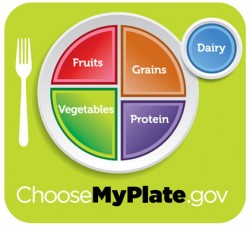 The days of the food pyramid are long gone. Federal dietary guidelines are now included in a new resource called MyPlate.
The days of the food pyramid are long gone. Federal dietary guidelines are now included in a new resource called MyPlate.
Policymakers, food-industry executives and medical and nutrition experts are endeavoring to provide answers to many of the questions American consumers have about their dietary needs. MyPlate recommends that people fill half their plate with vegetables and fruits, and then devote a small section to grains, meats and dairy. The diagram is split into different sections of approximately 20 percent protein, 10 percent fruits, 40 percent vegetables and 30 percent grains. Another habit encouraged by dietary experts is to add oils and fats sparingly.
In order to market the new program, the USDA has partnered with a number of health groups and organizations including NCES, Nasco Nutrition, Learning Seed, Learning ZoneXpress and Food and Health Communications.
Americans consume too much sugar, fat, oil and protein, according to USDA dietary experts. Throughout the course of a year, the average American consumes more than twice as much sugar as the dietary recommendation. On the other hand, people are not getting enough fruits, vegetables and dairy in their diets.
The Food and Drug Administration has recently issued new rules for restaurants and other food establishments so that consumers can make better decisions about their health. Food providers are required to publish calorie counts for all of their menu items, anything from popcorn and soda to pancakes and bacon. In connection with this new change, businesses are now trying to create effective methods for reducing salt and sugar in their products.
Although a whole host of food companies have followed the trend of “low-fat” products, the transition has been a slow one. Many of the leading manufacturers are now beginning to upgrade foods such as yogurts and breakfast cereals to fall in line with the new requirements.
Leave a Reply
You must be logged in to post a comment.